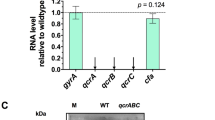Abstract
Escherichia coli grown with glucose in the absence of added electron acceptors contained 3–4 times more naphthoquinones (menaquinone plus demethylmenaquinone) than in the presence of O2. Presence of electron acceptors resulted in a slight additional increase of the naphthoquinone content. A strain defective in the fnr gene, which encodes the transcriptional activator of anaerobic respiration, showed the same response. With fumarate or dimethyl sulfoxide present, 94% of the naphthoquinones consisted of menaquinone, while with nitrate up to 78% was demethylmenaquinone. With trimethylamine N-oxid as the acceptor the proportion was intermediate. From the donor substrates of anaerobic respiration only glycerol had a significant influence on the ratio of the contents of the 2 quinones. It is concluded that FNR, the gene product of the fnr gene, is not required for anaerobic derepression of naphthoquinone viosynthesis. Menaquinone appears to be involved specifically in the respiration with fumarate or dimethyl sulfoxide, and demethylmenaquinone in nitrate respiration. Both naphthoquinones appear to serve in trimethylamine N-oxide respiration.
Similar content being viewed by others
Abbreviations
- DMK:
-
demethylmenaquinone
- MK:
-
menaquinone
- Q:
-
ubiquinone
- DMSO:
-
dimethyl sulfoxide
- TMAO:
-
trimethylamine N-oxide
- HPLC:
-
high performance liquid chromatography
References
Bode CH, Goebell H, Stähler E (1968) Zur Eliminierung von Trübungsfehlern bei der Eiweißbestimmung mit der Biuretmethode. Z Klin Chem Klin Biochem 5:419–422
Bronder M, Mell H, Stupperich E, Kröger A (1982) Biosynthetic pathways of Vibrio succinogenes growing with fumarate as terminal electron acceptor and sole carbon source. Arch Microbiol 131:216–223
Castell CH (1950) The influence of trimethylamine oxide on the bacterial reduction of redox indicators. J Fish Res Bd Can 7:567–575
Chippaux, M, Giudici D, Abou-Jaoude A, Casse F, Pascal MC (1978) A mutation leading to the total lack of nitrite reductase activity in Escherichia coli K12. Mol Gen Genet 160:225–229
Collins MD, Jones D (1981) Distribution of isoprenoid quinone structural types in bacteria and their taxonomic implications. Microbiol Rev 45:316–354
Collins MD, Fernandez F (1984) Menaquinone-6 and thermoplasmaquinone-6 in Wolinella succinogenes. FEMS Microbiol Lett 22:273–276
Guest JR (1977) Menaquinone biosynthesis: Mutants of Escherichia coli K-12 requiring 2-succinylbenzoate. J Bacteriol 130:1038–1046
Guest JR (1979) Anaerobic growth of Escherichia coli K12 with fumarate as terminal electron acceptor. Genetic studies with menaquinone and fluoro-acetate-resistent mutants. J Gen Microbiol 115:259–271
Holländer R (1976) Correlation of the function of demethylmenaquinone in bacterial electron transport with its redox potential. FEBS Lett 72:98–100
Ingledew WJ, Poole RK (1984) The respiratory chains of Escherichia coli. Microbiol Rev 48:222–271
Kröger A, Dadák V (1969) On the role of quinones in bacterial electron transport. The respiratory system of Bacillus megaterium. Eur J Biochem 11:328–340
Kröger A (1978) Fumarate as terminal acceptor of phosphorylative electron transport. Biochim Biophys Acta 505:129–145
Kröger A, Unden G (1985) The function of menaquinone in bacterial electron transport. In: Lenaz G (ed) Coenzyme Q. John Wiley, Chichester, pp 285–300
Kroppenstedt RM (1985) Fatty acid and menaquinone analysis of Actinomycetes and related organisms. In: Goodfellow M, Minnikin E (eds) Chemical methods in bacterial systematics. Academic Press, London, pp 173–199
Lambden PR, Guest JR (1976) Mutants of Escherichia coli K12 unable to use fumarate as an anaerobic electron acceptor. J Gen Microbiol 97:145–160
Meganathan JR (1984) Inability of men mutants of Escherichia coli to use trimethylamine-N-oxide as an electron acceptor. FEMS Microbiol Lett 24:57–62
Miller JH (1972) Experiments in molecular genetics. Cold Spring Harbor Laboratory, Cold Spring Harbor New York
Newman BM, Cole JA (1978) The chromosomal location and pleiotropic effects of mutations of the nir A + gene of Escherichia coli K12: The essential role of nirA + in nitrite reduction and in other anaerobic redox reactions. J Gen Microbiol 106:1–12
Newton NA, Cox GB, Gibson F (1971) The function of menaquinone (vitamin K2) in Escherichia coli K-12. Biochim Biophys Acta 244:155–166
Patric JM, Dobrogosz WJ (1973) The effect of cyclic AMP on anaerobic growth in Escherichia coli. Biochim Biophys Res Commun 54:555–561
Polglase WJ, Pun WT, Withaar J (1966) Lipoquinones of Escherichia coli. Biochim Biophys Acta 118:425–426
Rickenberg, HV (1974) Cyclic AMP in prokaryotes. Ann Rev Microbiol 28:353–369
Shaw DJ, Guest JR (1982) Nucleotide sequence of the fnr gene and primary structure of the Fnr protein of Escherichia coli. Nucl Acid Res 10:6119–6130
Shaw DJ, Rice DW, Guest JR (1983) Homology between CAP and Fnr, a regulator of anaerobic respiration in Escherichia coli. J Mol Biol 166:241–247
Thauer RK, Jungermann K, Decker K (1977) Energy conservation in chemotrophic anaerobic bacteria. Bacteriol Rev 41:100–180
Unden G, Kröger A (1982) Reconstitution in liposomes of the electron transport chain catalyzing fumarate reduction by formate. Biochim Biophys Acta 682:258–263
Unden G, Guest JR (1984) Cyclic AMP and anaerobic gene expression in E. coli. FEBS Lett 170:321–325
Unden G, Guest JR (1985) Isolation and characterization of the Fnr protein, the transcriptional regulator of anaerobic electron transport in Escherichia coli. Eur J Biochem 146:193–199
Unden G, Duchene A (1987) On the role of cyclic AMP and the Fnr protein in Escherichia coli growing anaerobically. Arch Microbiol 147:195–200
Wallace BJ, Young IG (1977) Role of quinones in electron transport to oxygen and nitrate in Escherichia coli. Biochim Biophys Acta 461:84–100
Whistance GR, Threlfall DR (1968) Effect of anaerobiosis on the concentrations of demethylmenaquinone, menaquinone and ubiquinone in Escherichia freundii, Proteus mirabilis and Aeromonas punctata. Biochem J 108:505–507
Wood PM (1981) The redox potential for dimethyl sulphoxide reduction to dimethyl sulphide. FEBS Lett 124:11–14
Author information
Authors and Affiliations
Rights and permissions
About this article
Cite this article
Unden, G. Differential roles for menaquinone and demethylmenaquinone in anaerobic electron transport of E. coli and their fnr-independent expression. Arch. Microbiol. 150, 499–503 (1988). https://doi.org/10.1007/BF00422294
Received:
Accepted:
Issue Date:
DOI: https://doi.org/10.1007/BF00422294




